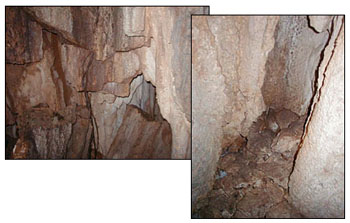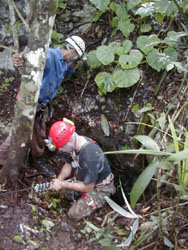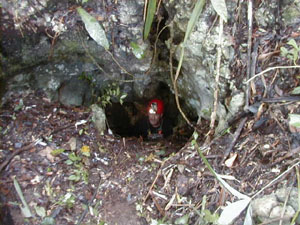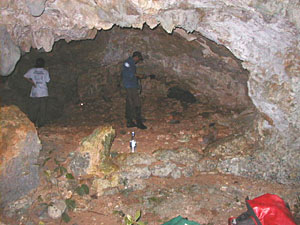|
The Excitement Builds
Our plan for day seven was to check out points X1 and X2, then go visit the small cave that William and Bruce had located on day four. At this point we were getting a little bit discouraged by the many long hikes we had taken into the jungle without finding "droppable" sinkhole features. Despite this, we mustered our energy and enthusiasm and headed out to the jungle to locate the two new points.
After a brief drive and a short trek of hacking through the jungle, we arrived at point X2. We were very excited to find a small sinkhole in the side of the hill that actually had some depth!
Bruce rappelled down into the pit approximately 10 meters to the bottom. He checked out the area but there were no tunnels branching out that permitted further passage. He came out of the hole and reported that it did not appear that the Maya had used this particular sinkhole.
We loaded up our gear and headed along the mountainside toward point X1. The point was only 80 meters away, and we hit another sinkhole! Again, we wasted no time and began the slow descent into the pit. The pit dropped down approximately 10 meters, and the area at the bottom was much more spacious than that in the sinkhole at point X2. The area was approximately three meters in diameter with a small passage leading away terminating at about three meters. We immediately noticed that the cave formations at the bottom of the pit appeared to be clipped or broken off. Because of the vertical nature of the sinkhole and the fact that the broken formations were tucked underneath the entrance, it is likely that these formations were broken by the ancient Maya.
There were a number of constricted passages leading away from the area at the bottom of the sinkhole that were too tight to permit human traffic. However, a number of these were blocked by piles of stones and speleothems, which were likely placed there by the Maya. It is possible that these rocks block passages that were used by the ancient Maya, and perhaps lead to lower depths and potentially a larger cave system. Future investigations are necessary to evaluate this possibility.

| Cave formations had been broken off (left), and piles of them blocked several passageways (right). |
We climbed out of the sinkhole and had our celebratory moment. Our day had been quite successful, having located two sinkholes that we could drop into, one bearing evidence of ancient Maya use.
We decided to then visit the small cave that Bruce and William had discovered a few days before. We ended our 30-minute hike by climbing up a steep mountain slope to a small cave entrance. Just inside the entrance was a low platform two courses high that was built by the ancient Maya. Pottery sherds and animal bones littered the entrance. One of the interesting aspects of the platform architecture was the inclusion of a large speleothem--most likely a stalagmite--in the center of the platform (see left). Since this cave formation was not created in its current position, we believe it was added to the architecture by the Maya.
The back wall of the cave by the ceiling exhibited a very interesting configuration of rock. It appears that the Maya chipped around a dark layer of cave deposit, perhaps to create a crude form out of the rock (see left). During our visit we came to no concrete conclusion about what this was intended to be. However, there was a distinctly round section of the rock that appeared to be connected to a spindly "body." The overall appearance was that of a human figure with an arm extended, possibly holding a staff or scepter. This interpretation should be considered tenuous at best, as we did not have enough time to investigate this feature extensively. Further investigations in this cave will be conducted in the 2002 season by the Western Belize Regional Cave Project.
After visiting the small cave we hiked out of the jungle and drove back to Chechem Ha Camp. We felt that the day was an overall success, as we had found two sinkholes and visited a cave with interesting architecture and possible artwork.
| 





